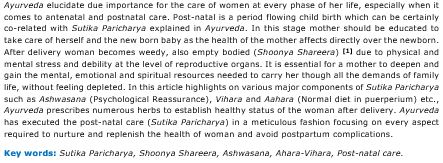Sutikopakrama key for Healthy Mother and Healthy Child
Abstract
Ayurveda elucidate due importance for the care of women at every phase of her life, especially when it comes to antenatal and postnatal care. Post natal is a period flowing child birth which can be certainly co-related with Sutika Paricharya explained in Ayurveda. In this stage mother should be educated to take care of herself and the new born baby as the health of the mother affects directly over the newborn. After delivery woman becomes weedy, also empty bodied (Shoonya Shareera)[1] due to physical and mental stress and debility at the level of reproductive organs. It is essential for a mother to deepen and gain the mental, emotional and spiritual resources needed to carry her though all the demands of family life, without feeling depleted. In this article highlights on various major components of Sutika Paricharya such as Ashwasana (Psychological Reassurance), Vihara and Aahara (Normal diet in puerperium) etc., Ayurveda prescribes numerous herbs to establish healthy status of the woman after delivery. Ayurveda has executed the post-natal care (Sutika Paricharya) in a meticulous fashion focusing on every aspect required to nurture and replenish the health of woman and avoid postpartum complications.
Downloads
References
Vaghbhata. In, Prof. K.R. Srikantha Murthy. Astanga Samgraha of Vagbhata, Varanasi: Chaukhambha Orinetalia; 1999. Vol 2 p. 42
Vruddha Jeevaka, Kashyapa. In, Kasyapa-Samhita, Varanasi: Chaukhambha Vishva Bharati; 1996. p.576
Agnivesha, Charaka. In, Vaidyajadavaji Trikamji Acharya. Charaka Samhita by Agnivesha revised by Charaka and Dridhabala of Chakrapanidatta, Varanasi: Chaukhambha Orientalia.2015. p.349
Sushrutha, Nagarjuna. In, Vaidyajadvji Trikamji Acharya. Sushrutha Samhita of Susruta, Varanasi: Chaukhambha Sanskrit Sansthan; 2012. p.389.
Vagbhata, In, Dr Anna Moreshwar Kunat. Ashtanga Hridaya - Arunadatta Sarvagasundara, Hemadri Ayurveda Rasayana Teeka, Varanasi: Chaukhambha Samskrita Samsthana; 2012. p.376
Vaghbhata. In, Prof. K.R. Srikantha Murthy. Astanga Samgraha of Vagbhata, Varanasi: Chaukhambha Orinetalia; 1999. Vol 2 p. 42
Vruddha Jeevaka, Kashyapa. In, Kasyapa-Samhita, Varanasi: Chaukhambha Vishva Bharati; 1996. p.574
D.C. Dutta, Hiralal Konar. Textbook of Obstetrics including Perinatology and Contraception: New Central Book of Agency (P) Ltd, London; Seventh Edition. 2011, p.144
Vruddha Jeevaka, Kashyapa. In, Kasyapa-Samhita, Varanasi: Chaukhambha Vishva Bharati; 1996. p.575

Copyright (c) 2022 Sankanagoud Patil, Nanda KO, Anushree ABC

This work is licensed under a Creative Commons Attribution-NonCommercial-ShareAlike 4.0 International License.
Journal of Ayurveda and Integrated Medical Sciences (JAIMS) retains the copyright of the contents of this journal but grant the readers the right to use the contents with terms and conditions under a creative common attribution licenses 4 of Attribution, Share Alike and Non-commercial type (CC BY-NC-SA) that allows copy, distribute, display, and perform the work and make derivative works based on it only for non-commercial purposes.

This work is licensed under a Creative Commons Attribution-NonCommercial-ShareAlike 4.0 International License.












